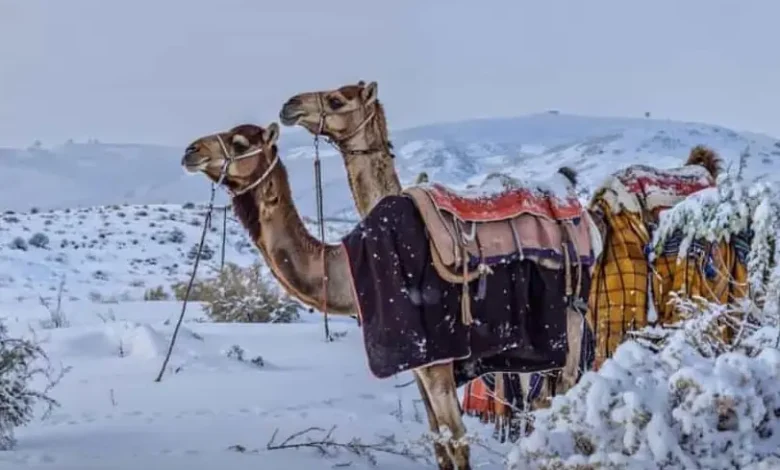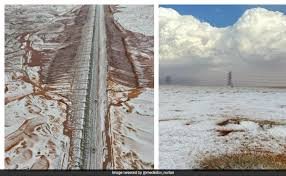Saudi Arabian Desert Snowfall: A Rare Natural Wonder Explained

Introduction: Snow in the Desert? Yes, It’s Real!
Saudi Arabian Desert Snowfall When people hear the phrase “desert snowfall,” most think it’s a contradiction. Deserts are supposed to be hot, dry, and sun-scorched, right? But Saudi Arabia has proven that even the most unlikely weather can happen in the unlikeliest places. Every few years, snowfall blankets certain parts of the Saudi Arabian desert, creating surreal landscapes that combine icy white snow with golden sand dunes.
Saudi Arabian Desert Snowfall This rare meteorological event has sparked global fascination. Videos of camels standing on snow-covered sand and children making snowmen in the desert often go viral. But what’s behind this unusual occurrence? Is it due to climate change, or has it always happened from time to time? Let’s dive into the phenomenon of Saudi Arabian desert snowfall.
The Geography and Climate of Saudi Arabia
Saudi Arabian Desert Snowfall is mostly covered by vast deserts, the most famous being the Rub’ al Khali, or the Empty Quarter. It’s one of the largest continuous sand deserts in the world, stretching over parts of Saudi Arabia, Oman, the UAE, and Yemen. Traditionally, the climate here is harsh, with summer temperatures soaring above 50°C (122°F) and winter bringing chilly nights but rarely below freezing.
Despite this, the northern and elevated parts of Saudi Arabia, especially areas like Tabuk and the Sarawat Mountains, experience colder winters. These regions sit at higher altitudes, making them more prone to occasional cold snaps. And when those cold snaps collide with moist air masses, snow can fall—even in the desert.
Historically, snowfall in Saudi Arabia is not entirely new. Local records and oral histories suggest that snow has fallen periodically in the northern deserts for centuries. However, modern media coverage and smartphones have helped the rest of the world witness it, making it feel more recent and surprising than it actually is.
The Meteorology Behind Desert Snowfall
Saudi Arabian Desert Snowfall So, how does snow end up falling in such an arid and hot part of the world? It all comes down to the right combination of weather conditions. For snow to fall, the atmosphere must have both moisture and freezing temperatures. While the Saudi desert is dry most of the year, during the winter months—especially between December and February—cold fronts from Eastern Europe and Central Asia occasionally sweep across the Arabian Peninsula.
Saudi Arabian Desert Snowfall When these cold fronts meet low-pressure systems carrying moisture from the Mediterranean or Red Sea, the result can be precipitation. If temperatures drop low enough, that precipitation can fall as snow instead of rain. In places like Tabuk, where elevation is above 700 meters (2,300 feet), temperatures can easily dip below zero during these cold fronts, creating just the right conditions for snowfall.
Interestingly, snowfall events are often short-lived and localized. Snow might fall for a few hours and melt the next day. Still, the sight of snow-covered dunes is breathtaking and unexpected for residents and travelers alike.

Memorable Snowfall Events in Saudi Arabia
Saudi Arabian Desert Snowfall One of the most widely reported desert snowfalls occurred in January 2016, when parts of northern Saudi Arabia were blanketed in snow for several days. The Tabuk region saw temperatures plummet, and snow covered everything from highways to hills. Camels, known as “ships of the desert,” were seen wandering through snow—a sight that felt almost mythical.
Saudi Arabian Desert Snowfall Another remarkable snowfall event happened in February 2020. Again, the northern regions saw heavy snowfall, attracting both locals and tourists. Families flocked to the hills to enjoy winter sports like sledding, snowball fights, and building snowmen—activities not typically associated with Saudi Arabia.
Even more recently, in January 2023, videos circulated of desert areas near Al-Jawf and Tabuk once again being blanketed with snow. These images went viral, reigniting discussions about climate change and whether these snowfalls were becoming more frequent.
The Cultural and Social Reaction to Snowfall
Saudi Arabian Desert Snowfall, especially those in the northern regions, snowfall is not just a weather anomaly—it’s a cause for celebration. Social media platforms light up with pictures, memes, and live videos. Local news outlets report on snow depth, road closures, and public safety warnings.
Saudi Arabian Desert Snowfall families seize the opportunity to travel north, turning snowfall events into mini holidays. Traditional foods like hot dates and tea are shared, and campfires become gathering spots in the chilly desert air. Some residents even rent four-wheel drives to explore snow-covered dunes.
Saudi Arabian Desert Snowfallingly, this cultural response shows how adaptable people are to changes in nature. Instead of being seen as a threat, desert snow in Saudi Arabia is often treated as a blessing and a novelty. In a land where summer heat dominates most of the year, winter snow offers a temporary, magical escape.
Is Climate Change Playing a Role?
Saudi Arabian Desert Snowfall unusual weather occurs, people wonder whether climate change is the cause. In the case of desert snowfalls in Saudi Arabia, the answer is both yes and no. Snowfall in the region is not entirely new, but there’s evidence suggesting that extreme weather patterns—both hot and cold—are becoming more frequent globally due to climate change.
Warmer oceans and atmospheric shifts have changed how cold fronts and moisture systems behave. Some scientists believe that the warming Arctic is altering jet stream patterns, making it more likely for cold air to dip farther south than usual. This could partly explain why Saudi Arabia occasionally experiences cold enough conditions for snow.
However, it’s important to note that a single snowfall does not prove or disprove climate change. What matters is the long-term trend. Still, the fact that snow now gets global attention when it falls in a desert highlights the growing awareness of our changing climate.
Tourism and Economic Impact of Snowfall Events
Believe it or not, snow in the Saudi desert is starting to influence tourism. With the Kingdom pushing for diversification through its Vision 2030 initiative, unusual attractions like snow-covered deserts are being highlighted as travel opportunities. Winter festivals, guided tours, and desert snow excursions have all started popping up.
Local businesses also benefit. Hotels in cities like Tabuk see a surge in bookings when snow is expected. Cafés and roadside stalls offer warm treats, and even outdoor clothing shops experience a spike in demand for jackets, gloves, and boots—items not typically needed in most parts of the country.
If desert snowfall continues, it could become a seasonal attraction. Saudi Arabia is already investing in winter sports infrastructure in places like Al-Ula and NEOM, and natural snowfall could complement these plans in the future.
Conclusion: A Rare Wonder That Captures the World’s Imagination
Snow in the Saudi Arabian desert is one of nature’s most surprising spectacles. It challenges our assumptions about what deserts are “supposed” to be like and reminds us of the planet’s incredible diversity. Whether it’s due to shifting weather patterns or simply rare atmospheric conditions, each snowfall brings awe, joy, and a sense of wonder to those who witness it.
For the people of Saudi Arabia, it’s more than just cold weather—it’s a celebration, a chance to connect with nature in a unique way, and a reminder that even the most unlikely places can turn magical under the right conditions.
So next time you see a video of camels walking through snow or dunes turned white overnight, don’t doubt it. Saudi Arabian desert snowfall is real, rare, and completely fascinating.



